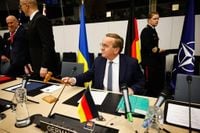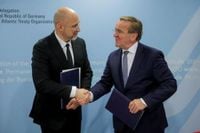In a significant move aimed at bolstering Ukraine’s defenses amid intensifying Russian attacks, Germany has pledged more than $2.3 billion in new military aid to Kyiv. The announcement came on October 15, 2025, during a high-profile Ukraine Defense Contact Group meeting held in Brussels, where German Defense Minister Boris Pistorius delivered the news alongside key Western allies and Ukrainian officials.
The new aid package represents one of Germany’s largest single contributions to Ukraine since the onset of Russia’s full-scale invasion nearly four years ago. It comes at a time when Ukraine is facing mounting pressure on the battlefield and a sharp decline in foreign military assistance. According to Suspilne and The Kyiv Independent, Pistorius made it clear that Germany intends to "continue and expand our support for Ukraine." He stated, "With new contracts, Germany will provide additional support amounting to over 2 billion euros [$2.3 billion]."
So, what exactly is included in this substantial package? Pistorius outlined a suite of advanced weaponry and support systems designed to address Ukraine’s most urgent military needs. Among the highlights are additional Patriot air defense interceptors, radar systems, precision-guided artillery, rockets, and ammunition. The package also features two more IRIS-T air defense systems, each accompanied by a large supply of guided missiles and shoulder-fired air defense weapons. In addition, Germany will deliver anti-tank weapons, small arms, and secure communications systems, all of which are vital for Ukraine’s ongoing resistance.
"The package addresses a number of urgent requirements of Ukraine. It provides air defence systems, Patriot interceptors, radar systems and precision guided artillery, rockets and ammunition," Pistorius told the assembled delegates in Brussels, as reported by AFP. He emphasized that Germany’s support would not stop at providing new equipment. There are also plans to modernize previously delivered weapons, extending their operational lifespan and adapting them to the shifting conditions of the war. Pistorius added, "At the same time, we will continue to expand cooperation between Germany’s defense industry and Ukraine."
This deepening partnership is expected to take concrete shape soon. According to Suspilne, a memorandum of cooperation between the defense industries of Ukraine and Germany is set to be signed following the Brussels meeting. The goal is to further integrate the two countries’ defense sectors, ensuring that Ukraine can maintain and upgrade its arsenal even as the conflict drags on.
Of the total aid package, $500 million will be funneled through NATO’s Prioritized Ukraine Requirements List (PURL) mechanism. This initiative, as described by The Kyiv Independent, coordinates funding from European allies and Canada to purchase critically needed U.S.-made weapons for Ukraine. Since August, about $2 billion had already been allocated through this mechanism, but Germany’s new commitment marks a notable increase in the scale of support.
The urgency of these new pledges cannot be overstated. Ukraine’s Defense Minister Denys Shmyhal, who attended the Brussels meeting, laid out the stark reality facing his country. According to AFP, Shmyhal warned that Ukraine will require $120 billion in 2026 to continue resisting Russia’s aggression. "Ukraine will cover half, $60 billion, from our national resources. We are asking partners to join us in covering the other half," he said. The need for air defense systems is particularly acute. Shmyhal revealed that just last month, Russia launched over 5,600 strike drones and more than 180 missiles at Ukrainian civilian infrastructure and people.
Despite the ongoing efforts of Western allies, there are signs that military aid to Ukraine has been waning. The Kiel Institute in Germany, which tracks international support for Ukraine, reported that foreign military aid dropped by 43 percent in July and August compared to the first half of 2025. This decline comes at a perilous moment, as Russia steps up its aerial bombardment and Ukraine’s own resources are stretched thin.
U.S. Defense Secretary Pete Hegseth, also present in Brussels, underscored the importance of moving beyond promises to deliver real, tangible support. "All countries need to translate goals into guns, commitments into capabilities and pledges into power. That’s all that matters. Hard power. It’s the only thing belligerents actually respect," Hegseth said, according to AFP. His comments reflect a growing consensus among Ukraine’s Western partners that rhetoric alone will not turn the tide on the battlefield.
Germany’s latest aid package is designed not just to provide immediate relief but to lay the groundwork for a longer-term defense partnership. By committing to modernize and maintain previously delivered weaponry, Germany is signaling its intention to remain a key supporter of Ukraine’s military resilience. The planned memorandum of cooperation between the two countries’ defense industries is expected to facilitate technology transfer, joint production, and streamlined maintenance, giving Ukraine a more sustainable edge.
Meanwhile, the broader context remains fraught with uncertainty. While European arsenals have been largely depleted, only the United States still possesses a significant stockpile of the advanced weapons Ukraine most desperately needs. The PURL mechanism is helping to bridge some of these gaps by enabling European allies and Canada to purchase U.S. arms for Kyiv. However, the future of American support remains unclear. The administration of U.S. President Donald Trump has so far refrained from donating military equipment to Ukraine, though it is reportedly considering sending Tomahawk long-range missiles if Russia fails to de-escalate the conflict. Yet, as of now, it’s not clear who would foot the bill for those weapons should they be approved.
Against this backdrop, Germany’s commitment stands out as a beacon of continued Western resolve. The new aid package arrives as Ukraine’s needs are growing more acute and international attention is shifting to other global crises. By stepping up at this critical juncture, Berlin is signaling that it will not let Ukraine stand alone. As Pistorius put it, "You can count on Germany."
The coming months will test whether other Western allies follow Germany’s lead and whether these new resources can help Ukraine weather the storm of Russian aggression. For now, the message from Brussels is one of solidarity and determination—backed by real resources and a promise of deeper cooperation in the fight for Ukraine’s future.






